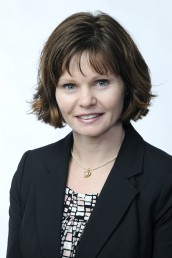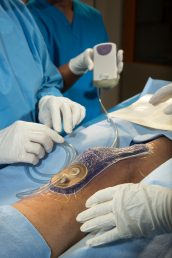UIC to lead study of negative pressure wound therapy in obese and diabetic patients
Surgical site infections are a significant complication that can prevent proper wound healing, require expensive treatment and may even lead to death in severe cases. Patients with higher body mass indices and with diabetes have an increased risk of developing incision infections.
With a $1.7 million, two-year grant from the Centers for Disease Control and Prevention, researchers in the University of Illinois at Chicago Epicenter for Prevention of Healthcare Associated Infections — one of six such centers funded by the CDC — will determine whether negative pressure wound therapy can help reduce the incidents of surgical site infections in obese and diabetic patients.
“Obese patients are more prone to develop surgical site infections because incisions tend to be larger and need to be deeper to allow surgeons to access the areas they need to work,” said Dr. Susan Bleasdale, associate professor of clinical medicine in the UIC College of Medicine and principal investigator on the grant.
“When these patients are healing, the incision may be covered by overlapping skin, which keeps the wound wet and can promote the development of infection. You want the wounds to stay dry,” explained Bleasdale, who is also director of infection control at the University of Illinois Hospital. Obese patients are also more likely to have diabetes, a condition which can further complicate and impede wound healing.
Negative pressure wound therapy uses a vacuum dressing to enhance and promote wound healing. It is often used to treat chronic, open wounds such as diabetic ulcers. A sealed wound dressing is applied to the incision and is attached to a pump to create a negative pressure environment at the incision site. Negative pressure helps increase blood flow to the area, keeps the edges of the incision intact, and draws out excess fluid.
The efficacy of negative pressure wound therapy has been evaluated in several small trials, including for promoting healing in cesarean-section incisions, but results have been mixed as to its benefits.
Bleasdale and her colleagues will evaluate the use of negative pressure wound therapy in obese and/or diabetic patients at five university-associated hospitals who have undergone C-sections, abdominal hysterectomy and colon procedures — three procedures that have elevated rates of incision site infection. They plan to enroll 3,300 participants in the trial. The universities participating in the study in addition to the UIC are the University of Utah, the University of Maryland, Emory University and the University of Iowa.
Participants will receive negative pressure wound therapy for seven days while patients in the control arm of the study will receive usual wound care. A subset of patients will be assessed after their therapy to evaluate their experience with the device.
In addition, a data analytics program will be used to evaluate the risk of surgical infection in individual patients. This decision support tool will be evaluated together with the use of the negative pressure wound therapy.
“While negative pressure wound therapy can cost a few hundred dollars, the cost of treating an infected incision can run in the thousands of dollars and can be life-threatening in certain cases,” said Bleasdale. “While the cost to purchase equipment for negative pressure wound therapy is initially high, over time, hospitals that use these devices may have lower costs associated with incision infections, and the cost per use will go down, as well. But we need to do this large, focused study to determine if the technique is an effective way to reduce wound infections in obese and diabetic patients because previous trials have been small with mixed results.”
Other investigators on the grant are Dr. Loreen Herwaldt at the University of Iowa Hospitals and Clinics; Dr. Jeanmarie Mayer at the University of Utah Hospital; Dr. Kerri Thom at the University of Maryland Medical Center; Dr. James Steinberg at Emory University Hospital Midtown, and Dr. Susan Ray at Grady Memorial Hospital in Atlanta.


